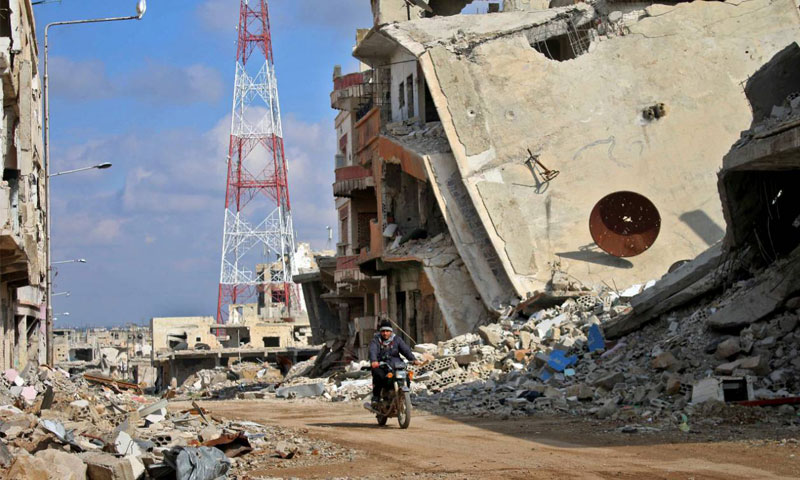Enab Baladi – Daraa
The geographical reality of the area of Daraa has been dictated by Assad forces’ reluctance to give up the international highway between Damascus and Amman. This forced the residents of the areas that are controlled by the opposition to take a longer and harder road that is filled with obstacles whenever they wanted to travel to the capital, after they have been used to paying only 35 Syrian pounds and spending less than an hour and a quarter to take the highway.
Despite the geographical remapping of the area and the way it has been divided often and again between opposition forces and Assad forces, and despite the fact that that division affected the residents of the area who found themselves caught in one part or the other, the residents who have to commute daily from one area to the other have to face an inescapable reality that they have to deal with whenever they want to travel, go to work or to a medical facility for treatment.
Three Risky Roads in which you can Get Arrested
There are three main routes to move from the opposition factions-held areas to the international highway, then to the road to Damascus: the first is through the Khirbet Ghazala checkpoint, the second through the Da’el checkpoint and the third passes through al-Sanamin checkpoint, in addition to another road that crosses Al-Suwayda province.
“It is not easy to get through the checkpoints,” said Ibrahim al-Khatib, a driver of one of the buses to the capital Damascus. He explained: “We start work at dawn and sometimes even before. We collect the passengers and get ready to reach the checkpoint early because it will take us a long time to get to the capital.”
The buses stop for several hours until they are allowed to enter the checkpoint for the inspection to start. Al-khatib pointed out that “the inspection involves rummaging through the entire bus, passengers and personal identity papers, and sometimes it takes two to three hours to pass the checkpoint. Then an even longer suffering at the military checkpoints of the Assad forces begins. ”
He said to Enab Baladi that “some checkpoints are easier to pass than others, except for Maktab al-Hatab and the Center checkpoints which are the busiest and in which the officers are notorious for treating passengers improperly.”
The two checkpoints are located in close proximity to the entrances of the capital, Damascus and are known for the many arbitrary arrests, as activists documented the arrest of hundreds of people, especially residents of Daraa, by Assad forces.
According to the driver, “Most of the detainees were arrested because of the place of birth written on their personal identity papers, as Assad Forces consider some of the towns of Hauran suspicious more than others, and they deliberately arrest young people and women arbitrarily to carry out give-and-take deals or to put pressure on their relatives working with the opposition factions.
The driver does not have options during the arrests. When one of the passengers gets arrested, the barrier officers ask him to complete the route, an order that has to be obeyed, while the rest of the passengers try to inform the detainee’s relatives of the incident.
Conditions that Force Civilians to Travel
The journey to Damascus may take more than seven or eight hours, and the passenger will then reach Bab Mousalla, which is the bus station from and to Daraa.
The cost of the trip exceeds two thousand Syrian Pounds per passenger in public transport, while taking private cars costs twice as much per passenger.
These hardships did not prevent civilians from traveling. The reasons for going to the capital are numerous, from university students and employees to people seeking treatment of chronic diseases, to those wishing to travel outside Syria after the Jordanian authorities closed the southern borders.
Maryam, the mother of one of the detainees in the Syrian regime’s prisons, said she travels every month to Damascus to visit her arrested son. She pointed out: “It is more difficult for men to go to the capital as the chances of getting arrested are a lot more serious compared to women, so most of those who go to visit or look for the detainee are women.”
The families of the detainees often go to Adra prison in Damascus countryside. Maryam clarified: “Often women gather in a village and rent a bus to visit their relatives in prison, and this trip is no different from other trips, whether in terms of suffering all along the road or the long time it takes to get there. ”
“Sometimes it takes us many hours at the checkpoints as a result of the traffic congestion, or checking and inspection, and we miss the date of the visit in prison, and all our efforts go in vain.”
Maryam tries to accurately choose the timing of the visit to travel to Damascus, and avoid the periods that witness fighting between the Assad forces and the opposition factions and the days during which the military units are mobilized along the way.

